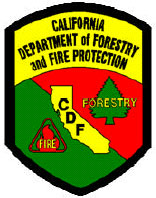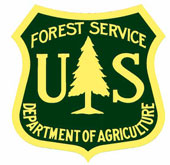
Tuolumne Fire
Helitack Crew 404 Burnover
Glen Allen Fire
Download 60-page Glen
Allen report, 4.6 mb pdf
Other Websites:
|

CDF Green Sheet
and
USFS 72 Hour Report
California Department of Forestry and Fire Protection
USDA Forest Service
 
CDF HELITACK 404 CREW BURNOVER
September 12, 2004
TUOLUMNE FIRE
CA-STF--2191
STANISLAUS NATIONAL FOREST
PACIFIC SOUTHWEST REGION
USDA-FOREST SERVICE
Lookouts Communications Escape
Routes Safety
Zones
A Board of Review has not approved this Summary Report. It
is intended as a safe ty and training tool, an aid to preventing future
occurrences, and to inform interested parties. Because it is published
on a short time frame, the information contained herein is subject
to revision as further investigation is conducted and additional information
is developed.
SUMMARY
On September 12, 2004 at approximately 1345 hours seven members of CDF
Columbia Helitack (Helicopter 404) crew were burned over while constructing
fireline from Lumsden Road downhill to the Tuolumne River on a steep slope
(80-120%). The fire was located near Lumsden Bridge in the bottom of the
Tuolumne River Canyon. The crew had been dropped off by Copter 404 on
a gravel bar in the river approximately ¾ mile downstream from
the fire. The crew met the incident commander (IC) on Lumsden Road before
reaching the fire. The helitack captain (HC) received a strategy briefing
to establish an anchor point on the right flank. He walked to the fire’s
edge and assessed the area below the road.
After discussing the assignment and safety issues, the crew members began
constructing indirect handline (7 to 30 feet from the fire’s edge)
downhill using a chainsaw and hand tools in an oak overstory with brush
fuels. The fire was backing into an up-canyon wind. A wind shift occurred
causing the fire to change direction and spread upslope into the crew.
Three members of the crew simultaneously shouted the alarm. All members
of the crew ran toward identified safety zones. Four members of the crew,
including the captain, went down to the river; three went up toward Lumsden
road. The four firefighters (FF) that went downhill reached their safety
zone. Of the three firefighters that went uphill, FF#1 and FF#2 made it
to the road. FF#3 was last seen by FF#2 immediately behind him approximately
5 feet from the road. FF#3 did not reach the road. Firefighters on-scene
estimated the elapsed time from the wind shift to the burn-over was less
than 30 seconds with the total wind event lasting less than 2 minutes.
Fire shelters were not deployed.
After reaching the safety zones a crew count determined that FF#3 was
missing; an immediate search was begun. FF#3 was located; she was obviously
deceased.
The other helitack firefighters received minor to moderate injuries.
They received immediate assistance at the scene and were transported to
medical facilities in Modesto and Sonora.
CONDITIONS
The fire location is in Tuolumne County at the bottom of the Tuolumne
River Canyon (1450’ elevation) about three (3) miles east of Groveland,
California. The Tuolumne River Canyon is a major Sierra Nevada river drainage
that has very steep canyon sides and is 2,000 feet deep at the accident
site. The fire originated near the river ¼ mile downstream of the
Lumsden Bridge.
The fire was first reported by The Stanislaus National Forest (STF) Duckwall
Lookout at 1233 hours. STF dispatched a standard wildland fire response.
Copter 404 was dispatched to the fire at 1245 hours from their home base
in Columbia, California (22 miles northwest of the fire). CDF Air Attack
440, 2 airtankers, and the IC were already at the scene upon the arrival
of Copter 404 at approximately 1305 hours. Copter 404 is a UH-1H Super
Huey (type 2) helicopter with a crew of nine, consisting of a pilot, two
helitack captains, and six firefighters. After dropping off one helitack
captain and six firefighters at a landing zone (LZ) about ¾ mile
southwest of the fire, the pilot and one helitack captain remained with
the copter and began making water drops up the right flank. At the time
of the burn over Copter 404 was working a spot fire off the left flank
of the fire.
The crew walked along the road from the LZ to the right flank of the
fire (the fire was burning above and below the road). The helitack captain
met the IC at Lumsden Road near South Fork Campground and received a briefing
on fire conditions and proposed strategy to anchor the right flank. The
crew continued up the road to the right flank, evaluated the situation
and the proposed assignment to anchor the right flank at the river.
Lumsden road parallels the river. The slope distance is approximately
260 feet from the road down to the river at the accident site. The fire
was burning upslope from the river with minimal lateral spread on the
right flank. The right flank was backing into a light up-canyon wind with
flame lengths of less than 12 inches.
FUEL
During the initial attack, the fire was spreading in light, flashy surface
fuels. The fuels were predominately live oak leaf litter, light grass,
and mixed brush, with an oak overstory consistent with Fuel Model 2. One-hour
fine dead fuel moisture was estimated at 4-5%. Live fuel moisture values
at the accident site were unavailable and no representative values were
available at the time of this report.
TOPOGRAPHY
The Tuolumne River Canyon is characterized by a meandering river channel
with numerous tributary canyons and ridges with slopes ranging from 80-120%.
The fire started below Lumsden Road on the south side of the river (north
facing slope).
WEATHER
| Temperature: |
89-94 F |
| Relative Humidity: |
18-24 % |
| Wind: |
Predominately steady up-canyon, estimated 3-5 mph (generally WSW).
Prior to the burn-over numerous observers (AA, C404 pilot, IC, crew
404) reported that the wind had remained light and steady flowing
in an up-canyon direction. |
No critical fire weather patterns (thunderstorms, frontal passage, etc.)
were in place.
SEQUENCE OF EVENTS
The tactic selected to establish the anchor at the river was indirect
line construction to take advantage of sparse fuel and natural barriers.
Five backpack pumps were staged on the edge of the road. The crew began
using one chainsaw and handtools to construct line downhill from the road
to the end of the vegetation (slope distance of 180 feet). The fire was
backing into an up-canyon wind. The initial point of the handline was
approximately 7 feet from the fire’s edge at the road; as the handline
progressed, the distance from the edge of the fire widened to approximately
30 feet. After line construction began the firing out operation started.
At approximately 1345 hours an abrupt wind shift occurred. The 90-120
degree windshift changed the fire spread from a cross-slope backing fire
to an upslope head fire. The wind event triggering the flare-up lasted
less than 2 minutes and the actual flare-up lasted approximately 30 seconds;
then fire behavior returned to a backing fire influenced by the up-canyon
wind.
The crew’s tool order consisted of FF#6 (chainsaw), FF#5 (swamper),
helitack captain (HC) with scraping tool, FF#4 (scraping tool), FF#3 (scraping
tool), FF#2 (scraping tool, fusee, and handie talkie ), and FF#1 (back
pump). The chain saw cut line extended approximately 120 feet and the
scraped portion extended approximately 40 feet. At this point FF #2 had
fired out approximately 10 feet of line. The HC directed FF#1 to retrieve
a backpack pump to support the firing operation. FF#1 returned to the
road to put on the backpack pump. FF#2 stopped firing and was standing
next to FF#3. STF Engine 43 had arrived at a turn-around on Lumsden Road
down canyon ¼ mile from the accident site. The captain and a firefighter
from Engine 43 walked the road from the turnaround to the right flank
and arrived seconds prior to the burn over.
FF#5 noticed a wind shift and saw a sheet of fire coming upslope toward
him and yelled to FF#6 to go downhill. Simultaneously FF#2 warned of the
wind shift and turned uphill along with FF#3 and began escaping up to
the road (approximately 20 to 30 feet away). HC yelled a warning; FF#4
saw a hole in the flames and ran downhill through the fire followed by
the HC. FF#1 heard yelling and turned to face the hand line. He saw a
run of fire heading up the hand line and yelled for the crew to get out
of there. FF#1 saw the lower crew members scattering downhill. FF#2 rolled
over the lip of the road within the oncoming flame front as the fire hit
the road. Although FF#2 and FF#3 were together within 5 feet of the road,
FF#3 did not arrive at the road.
FF#1 ended up on the road to the southwest toward STF Engine 43; FF#2
rolled into the inside cutbank of the road, jumped up and ran into the
black staying on the road. After going through the flames, FF#4 rolled
down the steep rocky embankment toward the river. HC, FF#5, and FF#6 ended
up in the safety area at the river. During this event the STF engine 43
captain and firefighter backed off toward the turn-around.
HC identified FF#4, FF#5, and FF#6 along the river and contacted FF#2
by radio. The two separate groups did a crew count and discovered that
FF#1 and FF#2 were accounted for and FF#3 was missing. They began an immediate
search and called for bucket drops and assistance in the search. Copter
404 responded from the spot fire on the left flank, refilled the bucket
near Lumsden Bridge, and flew ½ mile west to the accident site.
When Copter 404 arrived, the fire behavior had subsided to its previous
backing condition. Copter 404 began making bucket drops to cool the area
so the search could proceed. As the heat and smoke conditions subsided
HC, FF#1, FF#2, FF#5, and FF#6 began a grid search. Engine 43 arrived
at the right flank to assist in the search. As the smoke cleared and bucket
drops cooled the area, the searchers discovered the body of FF#3 located
in the newly burned area approximately 100 feet below the road.
Injuries
- HC had minor burns to the head and face.
- FF#1 had no reported physical injuries.
- FF#2 was treated for smoke inhalation and minor burns.
- FF#3 was deceased.
- FF#4 was treated for one fractured ankle and one broken rib; one twisted
ankle, and abrasions.
- FF#5 had no reported physical injuries.
- FF#6 had no reported physical injuries.
All surviving crew members were transported to hospitals for observation
and treatment.
Safety Issues for Review
- 10 Standard Orders
- 18 Situations that Shout Watch Out
- LCES
- Downhill Line Construction Guidelines.
|
